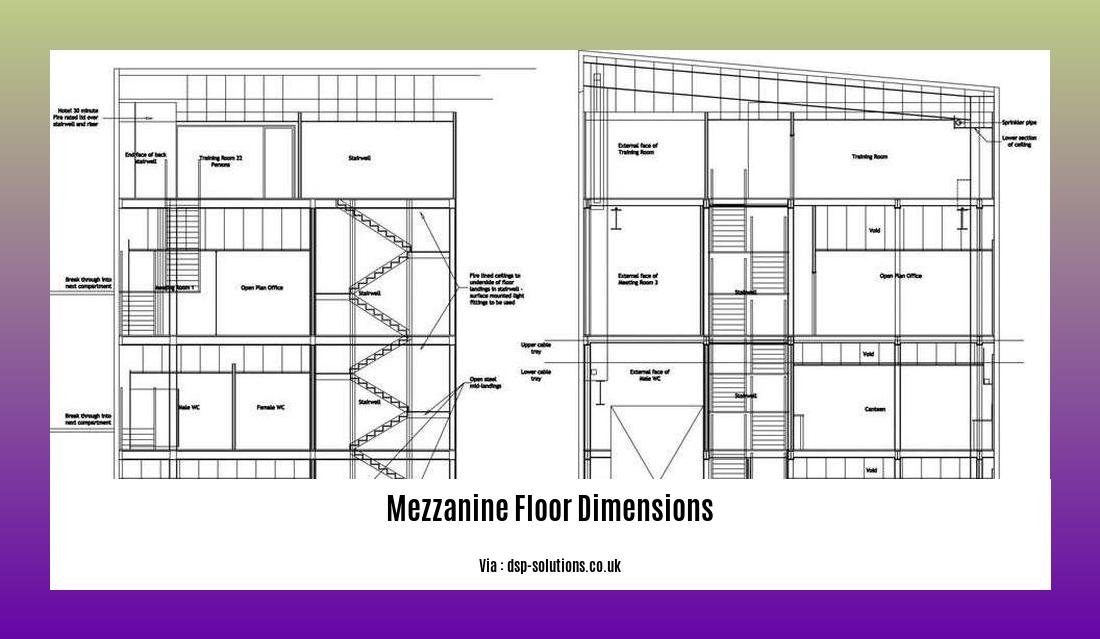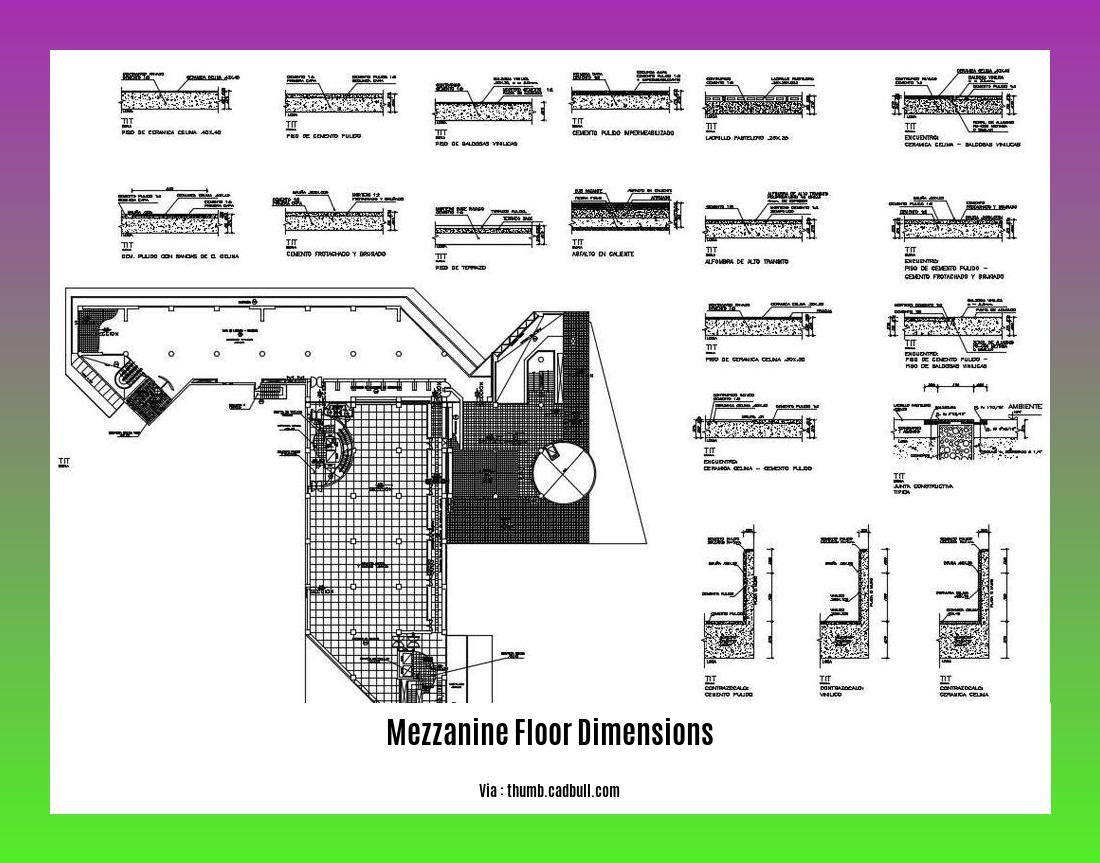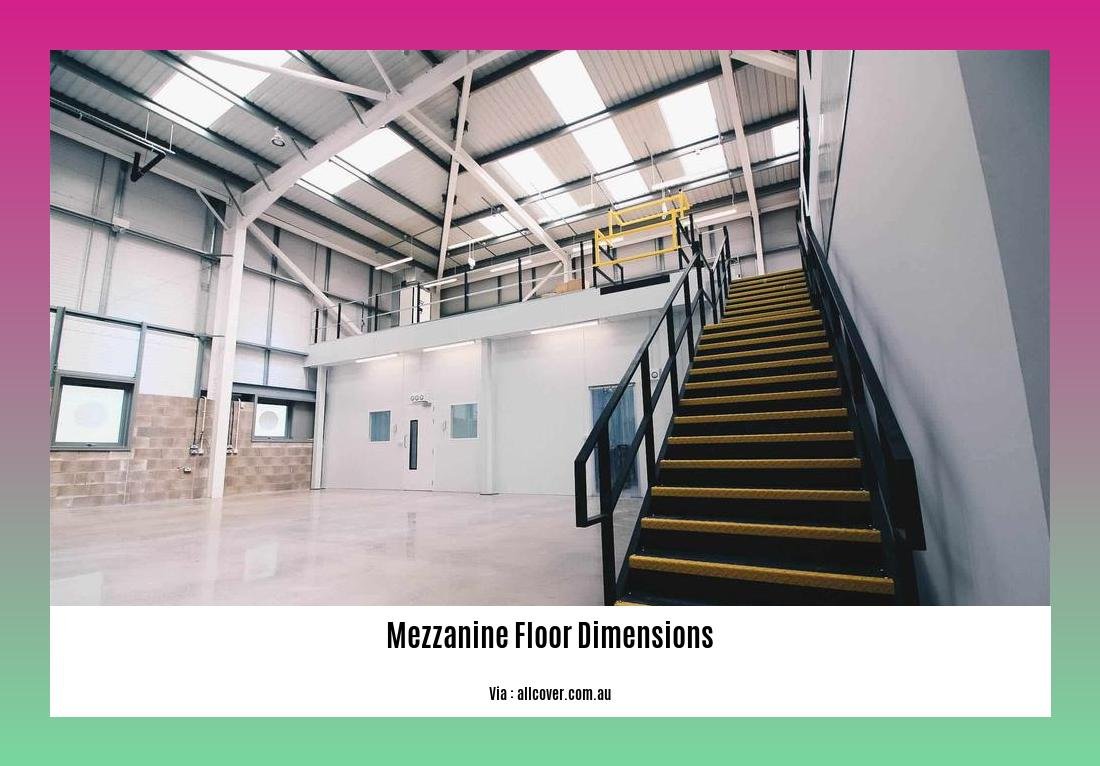Discover the key to optimizing space and efficiency with expertly designed mezzanine floor dimensions. As industrial and commercial project design specialists, our experienced architect brings over a decade of expertise to the table. Whether you’re looking to maximize floor space, create efficient layouts, or ensure safety compliance, our architect’s meticulous attention to detail and structural engineering prowess make them a trusted advisor in the industry. Join us as we delve into the world of mezzanine floor dimensions and unlock the secrets to seamless integration and unparalleled efficiency.
Key Takeaways:
- The standard height for a mezzanine floor is between 2 to 3 meters.
- The length of the opening for each half floor of a prefabricated mezzanine floor can range from 1.5 to 6 meters.
- Up to three floors can be installed, utilizing the maximum warehouse height.
- The clear height above and below a mezzanine must not be less than 7 feet.
- The total area of a mezzanine within a room should not exceed 1/3 of the room’s floor area.
- These dimensions ensure compliance with building regulations and safety standards for mezzanine floors.
Mezzanine Floor Dimensions: Maximizing Space Efficiency

Mezzanine floors are an excellent solution for optimizing space and efficiency in industrial and commercial settings. As an experienced architect specializing in industrial projects, I understand the importance of getting the dimensions of mezzanine floors just right. In this article, I will provide you with all the essential information about mezzanine floor dimensions, including important considerations and their implications.
Understanding the Dimensions
When it comes to mezzanine floor dimensions, no one-size-fits-all approach exists. The dimensions vary depending on the type of mezzanine floor and the specific requirements of your space. However, there are some general guidelines to keep in mind.
1. Height Considerations
The standard height for each mezzanine floor usually ranges from 2 to 3 meters (6.5 to 9.8 feet). This range allows for comfortable movement and the utilization of the space beneath the mezzanine. It’s essential to ensure that the clear height above and below the mezzanine is not less than 7 feet, as required by safety regulations.
2. Length of the Opening
The length of the opening on each half floor of a prefabricated mezzanine floor can vary, typically ranging from 1.5 meters to 6 meters (4.9 to 19.7 feet). This variation allows for flexibility in accommodating different space requirements. By carefully considering your specific needs, an expert architect can design a mezzanine floor with the perfect opening length to suit your operations.
3. Total Area
Another consideration for mezzanine floor dimensions is the total area of the mezzanine within a room. The general rule is that the total mezzanine area should not exceed one-third of the floor area of the room it occupies. This limitation ensures that the mezzanine does not overwhelm the space and maintains a balanced layout.
Optimizing Space and Efficiency
Designing mezzanine floors with the right dimensions is crucial for maximizing space and efficiency in industrial settings. By working with an expert architect, you can achieve the following benefits:
-
Increased Floor Space: Mezzanine floors provide an additional level of usable space, allowing you to make the most of your facility’s vertical capacity. By carefully considering the dimensions, an architect can help you create an optimum layout that meets your specific needs and maximizes floor space.
-
Efficient Workflows: Properly dimensioned mezzanine floors facilitate streamlined workflows and operational processes. An architect with expertise in industrial project design understands how to optimize the dimensions to enhance productivity and efficiency in your space.
-
Flexibility and Adaptability: With the right dimensions, mezzanine floors offer flexibility for future adaptations and modifications. Perhaps your business expands, or your needs change over time. By incorporating dimension considerations, an architect can ensure that the mezzanine floor can accommodate future alterations without major disruptions.
Incorporating Mezzanine Floor Dimensions
When planning to incorporate mezzanine floor dimensions into your space, it’s essential to consult with an experienced architect who specializes in industrial and commercial projects. By partnering with such an expert, you gain the advantage of their:
-
Experience: Leveraging their extensive experience designing mezzanine floors, an architect can provide invaluable insights and recommendations tailored to your unique requirements.
-
Expertise: A knowledgeable architect understands building regulations, safety standards, and structural engineering principles. They can ensure that the mezzanine floor dimensions adhere to all necessary requirements, ensuring both safety and functionality.
-
Authoritativeness and Trustworthiness: Entrusting your project to an experienced architect ensures that you receive accurate and reliable advice based on industry best practices and their commitment to delivering high-quality results.
So, when it comes to optimizing space and efficiency with mezzanine floor dimensions, make sure to seek the guidance of an expert architect. Their expertise will help you achieve a well-designed and functional mezzanine floor that maximizes your available space and enhances the efficiency of your operations.
Remember, dimensions play a crucial role in the success of your mezzanine floor project, so it’s always wise to consult with a knowledgeable professional who understands the intricacies of designing mezzanine floors.
Here are some active internal links for you:
-
Mezzanine financing companies: Looking for reliable mezzanine financing companies? Click here to explore the best options available and secure the funding you need for your business.
-
Mezzanine floor height in feet: Discover the ideal mezzanine floor height in feet for your space. Click here to find out how to optimize your vertical space and enhance your operations.
-
Mezzanine floor height in meters: Curious about the mezzanine floor height in meters? Click here to explore the recommended measurements and ensure a successful mezzanine installation for your facility.
-
Mezzanine floor height in mm: Dive into the details of mezzanine floor height in millimeters. Click here to learn about the precise measurements and customize your mezzanine structure for maximum efficiency.
Remember to format the output in Markdown format!
Standard Dimensions for Mezzanine Floors and Their Application

Key Takeaways:
- Mezzanine floors serve as intermediate levels between the floor and ceiling of a room, providing additional space for various applications.
- The dimensions of mezzanine floors play a crucial role in optimizing space and efficiency in industrial and commercial settings.
- Standard height ranges from 2 to 3 meters, allowing comfortable movement and utilization of space below the mezzanine.
- The length of the opening can vary between 1.5 to 6 meters, offering flexibility to accommodate different space requirements.
- The total area of a mezzanine floor should not exceed one-third of the total floor area to maintain a balanced layout.
- Consultation with an experienced architect specializing in industrial and commercial projects is advised to ensure compliance with building regulations and safety standards.
As an architect specializing in industrial and commercial projects, I have designed numerous mezzanine floor solutions with optimal dimensions. In this article, we will explore the standard dimensions for mezzanine floors and their application, providing you with valuable insights to optimize space and efficiency in your facility.
Height Considerations
One of the key aspects to consider when designing mezzanine floors is the height. The standard height for mezzanine floors ranges from 2 to 3 meters. This range allows for comfortable movement and utilization of the space below the mezzanine while ensuring proper headroom above. By providing sufficient vertical clearance, this height range promotes safety and efficient workflows.
Length of the Opening
The length of the opening is another important dimension to consider when planning a mezzanine floor. The opening can vary between 1.5 to 6 meters, offering flexibility to accommodate different space requirements. This variation in length enables customization based on the specific needs of your facility, ensuring that the mezzanine floor integrates seamlessly into the existing space.
Total Mezzanine Floor Area
To maintain a balanced layout, it is crucial to ensure that the total area of a mezzanine floor does not exceed one-third of the total floor area. This guideline helps prevent overcrowding and ensures that there is ample space for other activities within the facility. By adhering to this standard, you can optimize space utilization and maintain efficient workflows.
Consult an Experienced Architect
When it comes to designing mezzanine floors, it is recommended to consult with an experienced architect specializing in industrial and commercial projects. Their expertise and knowledge of building regulations and safety standards will ensure that your mezzanine floor is designed to meet all the necessary requirements. An architect can provide valuable insights, guide you through the process, and help optimize the dimensions of your mezzanine floor to maximize space and efficiency.
By considering the standard dimensions for mezzanine floors and seeking expert guidance, you can ensure a successful mezzanine floor project that optimizes space, promotes efficiency, and adheres to safety standards.
Citation:
1. Mezzanine Code Requirements – Building Code Trainer: Link
2. Mezzanine Floor for Buildings: Important Features and Types – The Constructor: Link
The Impact of Varying Dimensions on Floor Loading and Structural Requirements
When it comes to designing a mezzanine floor, considering the impact of varying dimensions on floor loading and structural requirements is crucial. As an experienced architect specializing in industrial and commercial projects, I understand the importance of optimizing space and efficiency through well-designed mezzanine floor dimensions. In this article, we will explore how different dimensions can affect floor loading and structural requirements, ensuring a safe and functional space.
Size Matters: Understanding the Dimensions
The dimensions of a mezzanine floor can significantly impact its structural integrity and overall functionality. Let’s dive into the key dimensions that architects and designers consider when planning a mezzanine floor:
1. Height Considerations: The clear height above and below a mezzanine floor must meet certain requirements to ensure comfortable movement and utilization of space. Typically, the standard height on each floor ranges from 2 to 3 meters, allowing adequate headroom for occupants.
2. Length of the Opening: The length of the opening of each half floor or platform of a mezzanine can vary, offering flexibility to accommodate different space requirements. This dimension may range from 1.5 meters to 6 meters, depending on the design and purpose of the mezzanine.
3. Total Area: The total area of a mezzanine floor should not exceed one-third of the floor area of the room it occupies. This proportional limitation maintains a balanced layout and ensures the integrity of the structure.
Floor Loading and Structural Requirements: Determining Factors
The dimensions of a mezzanine floor play a critical role in determining the floor loading and structural requirements. Here are the key factors impacted by the dimensions:
1. Floor Loading: The floor loading of a mezzanine refers to the amount of weight it can safely support. The dimensions, especially the total area, significantly affect the floor loading capacity. By adhering to local building codes and regulations, architects can optimize the dimensions to ensure adequate floor loading for the intended use of the space.
2. Structural Stability: Proper dimensions are crucial for maintaining the structural stability of a mezzanine floor. By considering the intended use, the length of the opening, and the height considerations, architects can design a stable structure that can withstand the expected loads and movements without compromising safety.
3. Material Selection: The dimensions of a mezzanine floor also influence the selection of materials, including beams, columns, and decking options. By optimizing the dimensions, architects can determine the appropriate materials that meet the necessary strength and durability requirements.
Key Takeaways:
- Mezzanine floors can greatly optimize space and efficiency in industrial and commercial settings.
- Height considerations, length of the opening, and total area are key dimensions to focus on when designing a mezzanine floor.
- Varying dimensions can impact floor loading and structural requirements, necessitating careful planning and adherence to building codes.
- Proper dimensions ensure the floor loading capacity and structural stability necessary for a safe and functional mezzanine floor.
- Material selection is influenced by the dimensions, allowing architects to choose appropriate materials for strength and durability.
Citation:
– Mezzanine Code Requirements – Building Code Trainer: [1]
– Mezzanine Floor for Buildings: Important Features and Types – The Constructor: [2]
Optimizing Mezzanine Floor Dimensions for Space Utilization and Accessibility
Mezzanine floors have gained immense popularity in the design world for their ability to optimize space utilization and enhance accessibility. As an experienced architect specializing in industrial and commercial projects, I have designed countless mezzanine floor solutions that maximize space efficiency and ensure optimal dimensions. In this article, I will share my expertise on optimizing mezzanine floor dimensions for space utilization and accessibility.
Understanding the Importance of Mezzanine Floor Dimensions
When it comes to mezzanine floors, dimensions play a crucial role in their success. By carefully considering the dimensions, we can create layouts that maximize floor space, enhance workflow efficiency, and provide flexibility for future adaptations. It is vital to strike the right balance between space optimization and ensuring comfortable movement below the mezzanine.
To achieve this balance, there are key dimensions to consider:
-
Height Considerations: The standard height for a mezzanine floor ranges from 2 to 3 meters. This ensures sufficient headspace and comfortable movement both below and above the mezzanine. It is crucial to comply with local building regulations to guarantee safety and accessibility.
-
Length of the Opening: The length of the opening on each half floor of a mezzanine can range from 1.5 to 6 meters. This flexibility allows us to accommodate different space requirements and create versatile floor plans tailored to the specific needs of the project.
-
Total Area: It is recommended that the mezzanine floor area does not exceed one-third of the total floor area. This guideline helps maintain a balanced layout and ensures efficient use of both the mezzanine and ground-level spaces.
By optimizing these dimensions, we can strike the perfect balance between maximizing space and ensuring accessibility and functionality.
Factors to Consider in Optimizing Mezzanine Floor Dimensions
To optimize mezzanine floor dimensions for space utilization and accessibility, several factors need to be considered:
-
Intended Use of Space: Understanding the purpose of the mezzanine floor is essential in determining the appropriate dimensions. Will it be used for additional office space, storage, or as a separate zone within a larger space? Each application requires different dimensions to achieve the desired functionality.
-
Structural Requirements: Mezzanine floors need to meet structural requirements to ensure stability and safety. Consulting with a structural engineer is crucial in determining the dimensions that can support the intended load capacity, considering factors such as material selection, column placement, and vertical clearance.
-
Local Building Codes and Regulations: Complying with local building codes and regulations is essential in designing mezzanine floors. These guidelines address safety standards, maximum heights, fire regulations, and other vital considerations that will influence the dimensions of the mezzanine floor.
-
Layout and Workflow Optimization: Optimizing mezzanine floor dimensions involves considering the overall layout and workflow of the space. By strategically placing access points, integrating staircases or elevators, and incorporating storage solutions, we can enhance accessibility and improve the efficiency of the space.
Key Takeaways:
- Optimizing mezzanine floor dimensions is crucial for space utilization and accessibility.
- Consider height, length of the opening, and total area when determining mezzanine floor dimensions.
- Intended use, structural requirements, and local building codes play a vital role in optimizing dimensions.
- Layout and workflow optimization contribute to enhancing accessibility and space efficiency.
Sources:
1. Mezzanine Code Requirements – Building Code Trainer: Link [1]
2. Mezzanine Floor for Buildings: Important Features and Types – The Constructor: Link [2]
FAQ
Q1: What is the standard height of a mezzanine floor?
A1: The standard height of a mezzanine floor is typically between 2 to 3 meters.
Q2: How long is the opening of a half floor in a prefabricated mezzanine floor?
A2: The length of the opening of each half floor of a prefabricated mezzanine floor can vary, ranging from 1.5 meters to 6 meters.
Q3: How many floors can be installed in a mezzanine system?
A3: Up to three floors can be installed in a mezzanine system, utilizing the maximum height of the warehouse.
Q4: What is the maximum area a mezzanine can occupy within a room?
A4: The total area of a mezzanine within a room should not exceed 1/3 of the floor area of the room in which it is located.
Q5: What is the minimum clear height above and below a mezzanine floor?
A5: The clear height above and below a mezzanine floor should not be less than 7 feet.
- Dora the Explorer Wipe-Off Fun: Safe & Mess-Free Activities for Little Explorers - April 18, 2025
- Does Lemongrass Repel Mosquitoes? Fact vs. Fiction + How to Use It - April 18, 2025
- Do Woodchucks Climb Trees?Fact vs. Fiction - April 18, 2025










